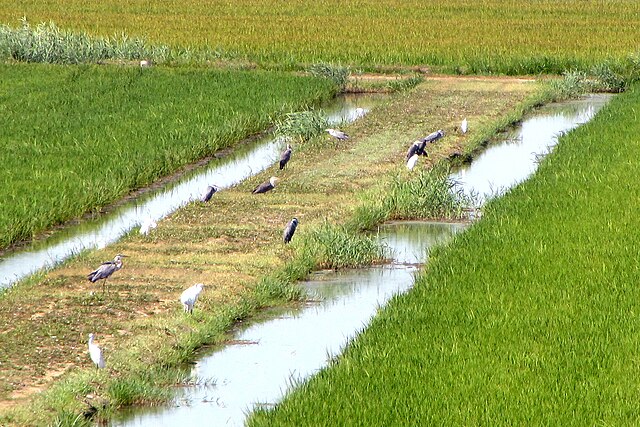Grain growers in northern Italy’s Ferrara province are battling flamingos that are wading flooded paddies and trampling germinating risotto-making rice.
According to the Associated Press on July 10, 2025, this province between Venice and Ravenna in northeast-central Italy is keeping night vigils.
Farmer Enrico Fabbri recounted how some of his paddies suffered 90% losses from the heedless trampling by the birds.
The flamingos seem to have emanated from Comacchio valley, south of the mouth of the agrarian River Po, on the Adriatic Sea. This long river feeds the country’s biggest rice paddies in the northern parts of Lombardy Province in north-central Italy.
Italy’s newest unlikely bird has been drifting northeastward since 2000 to escape drought in its native southern Spain and North Africa.
The bird uses its long feet to dig up molluscs and other aquatic pests that thrive on the sodden rice paddies.
Experts currently recommend flooding level reduction to just above 5 cm versus the usual 30 cm to offset splashes that attract flamingos.
Impact on Production and Risotto Cuisine
The birds pounced stark upon the spring-summer rice planting season, with adverse impact on germination.
These seedlings produce the famous Carnaroli and Arborio rice varieties that stud the 46,000 km2 of the northern Po River plain.
As of 2023, Italy accounted for 50% of the European Union (EU)’s annual rice output, mostly from this river’s basin.
Thanks to this huge output, dishes such as risotto, a stock rice with vegetables, butter, broth or seafood have grown famous.
The dish mostly comes out well from the short grain varieties that include arborio, which is among the most grown cultivars.
Although risotto pales before spaghetti, pizza and pasta, the creamy rice is a key part of the national cuisine and cultural identity.
Cities like Turin on the River Po in the northwest of the country celebrate with quasi-risotto meals each November harvest time. Locals here also make related dishes like Panissa (rice with pork, beans and spice).
Derived from the Italian name for rice ‘Riso,’ risotto is truly so only when butter and broth shape it into a creamy repast.
Now that rice is barely germinating in northern Italy before flamingos root it out, does it mean less risotto comfort for 2025? The statistics below explore some answers via production and trade statistics of the past.
Italy Rice and Risotto Statistics
Italy dominates rice production in the European Union (EU) at 1.3 million tonnes per year, as of 2024. While this output represents 50% of the EU’s capacity, 53% of the same ends up as exports within the bloc. Although by world standards Italy comes at position 35 in production, its rice is usually famous for high quality. This has helped the Mediterranean country not only export raw rice but foster trans-national dishes like risotto.
How high is rice consumption in Italy?
Italy is ironically a moderate consumer of rice, at position 66 worldwide, as of 2023, behind neighbors France and Germany. 2023 consumption volume was 532,000 tonnes while the per capita was at 9.01 kg per person per year. In comparison, the world’s 4th biggest rice consumption market, Bangladesh, topped individual intake at 246.85 kg per person per year.
Where does rice grow in Italy?
The Po River plain that covers 46,000 km2 in north-central Italy is the main source of rice and 35% of the national agricultural production. It covers such regions as northern Lombardy (Milan area), Ferrara and Vercelli (near Turin).
Is risotto a major dish in Italy?
Although whole wheat pasta have somewhat overshadowed it, risotto remains a foremost national dish. This is why it has regional affiliations: in Milan it is sometimes risotto alla Milanese while in Piedmont risotto al Barolo and in Veneto risi e bisi.
